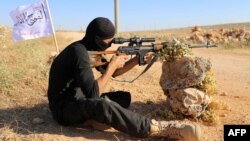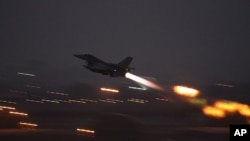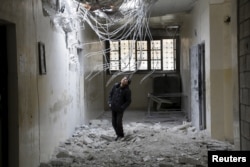A monthslong struggle for control of the northern Aleppo countryside between Syrian insurgent factions and Islamic State militants is at a stalemate, partly because Western and Gulf-backed rebel militias are being forced to reinforce south of Syria’s onetime commercial capital to combat Russian-backed Syrian army and Lebanese Shi'ite forces, admit insurgent commanders and fighters.
The impasse risks forcing the hand of Kurdish-led forces east of the Euphrates, encouraging them to cross the river en masse and finish the job the Western and Gulf-backed Free Syrian Army seems incapable of completing – ridding the northern Aleppo countryside of IS.
That would exacerbate disagreements within the U.S.-led international coalition. Turkey has threatened dire consequences, if the Kurdish-dominated Syrian Democratic Forces move further west.
The emboldened Syrian army backed by fighters from the radical Lebanese Shi'ite movement Hezbollah have made some inroads albeit slowly south and east of Aleppo — and they have made advances in the coastal province of Latakia.
“The Russian air campaign enabled additional battlefield gains by the Syrian regime from January 8 to January 14,” according to Genevieve Casagrande of the Institute for the Study of War, a think tank based in Washington, D.C., that monitors the military campaigns in the Levant.
Regained control
Over the weekend, regime forces regained control over the village of al-Ajozeyye in Aleppo’s eastern countryside.
And army spokesmen also claimed to have inflicted heavy losses on what they termed “terrorists” in al-Mansoura village and Khirbet Hazmar west of Aleppo.
The struggle in the northern Aleppo countryside adjacent to the border with Turkey is a key one and has become more complex with each passing month featuring on the ground regime forces, insurgents seeking to oust President Bashar al-Assad, IS — and, in the air, Syrian, Russian and U.S.-led coalition warplanes.
Rival ground forces sometimes are able to take advantage in skirmishes of airstrikes launched by their foes.
With a dizzying array of vying armed groups, jihadists and Syrian government-aligned forces battling each other in multiple micro-conflicts, friend can become foe, and foe can turn into a temporary ally with alarming speed — depending on where clashes are occurring.
Dizzying array of armed groups
Certainly in the battles and skirmishes around Aleppo, Syria’s largest city and onetime commercial capital, the struggle is getting messier by the day. Rebel commanders loudly accuse Damascus and Moscow of helping the Islamic State terror group with airstrikes on anti-Assad rebels.
They are slower to admit, though, that in parts of the eastern Aleppo countryside Russian airstrikes on IS inadvertently have helped the anti-Assad rebels.
Both anti-Assad rebels and the government, when it serves tactical military purposes, take advantage of the terror group's presence on the battlefield, if only indirectly, in their battles against each other.
In the northern Aleppo countryside, Islamic State fighters have been opportunistically leveraging Russia’s air campaign to press offensives on the rebel-held towns of Marea, Tal Rifat and Azaz.
“After Russian airstrikes they mount attacks on us,” says Abdul Rahman, a commander with the Ahfad Omer battalion, part of the larger First Brigade, a U.S.-backed secular militia.
But as the battles in the northern Aleppo countryside see-saw and stalemate — the control of villages can change hands day by day — the chances increase of the Kurdish-dominated Syrian Democratic Forces being tempted to intervene.
Dam seized
In December the SDF seized the October Dam on the Euphrates River, giving them access to the Aleppo countryside.
Some forces crossed west of the river — a red line for Ankara who fears the Kurds are intent on expanding their territory along the border to link up separated mainly Kurdish cantons.
For face-saving purposes, the Turks accepted that the SDF fighters who actually crossed were Arabs and Turkmen and not Kurds, prompting some observers to argue that the Turkish authorities were now prepared to accept the inevitable.
But Turkish officials have told VOA that is not so and that an en masse trespass by Kurdish fighters linked to Turkey’s outlawed Kurdistan Workers’ Party (PKK) would invite Turkish retaliation.
“Both Ankara and the Kurds rank each other far higher than Assad or the Islamic State on their respective lists of evils for urgent destruction,” argues Aron Lund, who writes the Syria in Crisis report for the Carnegie Endowment for International Peace, a US think tank.
For the U.S., Syrian Kurdish fighters have proven to be most effective allies against the Islamic State.
At the moment Turkey may stay its hand as Ankara has realized belatedly “its need for Western support and the costs of playing spoiler,” according to Lund.
But “these contradictions threaten to rip apart the United States’ Syrian alliance network, undermining its policy to pressure both Assad and the Islamic State,” he maintains.
The contradictions were apparent Sunday night when Islamic factions favored by Gulf countries clashed with SDF forces around Malkiya village in Aleppo’s northern countryside, according to the Syrian Observatory for Human Rights, a monitoring group based in London that relies on information from a network of political activists.

















